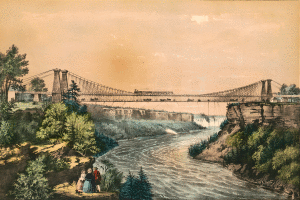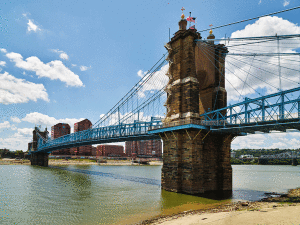




His government job of four years involved designing military roads and supervising their construction. He had also sketched suspension bridges that were never built.
In 1837 Mr. Roebling worked on projects to improve river navigation, in Pennsylvania. Realizing that hemp ropes were expensive and needed to be replaced often, John developed a seven-strand wire rope, which he began producing in 1841.
In 1848 when John Roebling began construction of four suspension aqueducts on the Delaware River for the D&H Canal, he moved to Trenton, New Jersey, and built John A. Roebling’s Sons Company, a large industrial complex for wire production.
In 1851 John Roebling designed a bridge that stretched over the Niagara River with two levels.
The railroad level connected the New York Central with Canada’s Great Western Railway. The other level was for vehicles.
The bridge, which spanned 825 feet and was supported by four, ten-inch wire cables, took four years to build.
In 1856 Roebling started a bridge over the Ohio River at Cincinnati. Due to lack of finances it was another seven years before work continued on the suspension bridge which spanned 1,057 feet from Cincinnati, Ohio to Covington, Kentucky. The bridge opened on December 1, 1866.
For more about his many projects, see John A. Roebling in Wikipedia.
Related information
Roebling Museum
East River Suspension Bridge
Caisson Sickness
Maine’s Androscoggin Swinging Bridge







